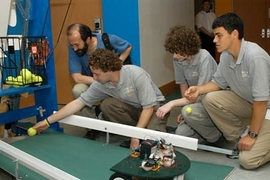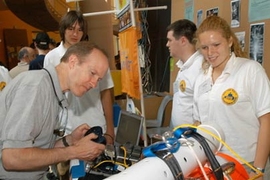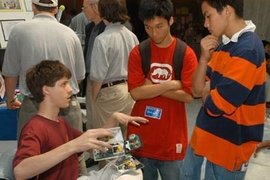Given $10,000 and nine months, 13 teams of high school students from across the country designed inventions to solve problems of their choice, from testing a watermelon's ripeness to a smoke detector for the hearing impaired.
The teams convened at MIT June 9 and 10 to showcase their inventions at the InvenTeams Odyssey, sponsored by the Lemelson-MIT Program. Each team of students, teachers and industry mentors had received grants of up to $10,000 to design and build a prototype during the 2004-2005 school year.
"It was a chance for me to relate my engineering experience from the classroom to a real-life situation, figuring out along the way that you need to modify things, because everything doesn't work out the way you want it to," said Joe Darby of the Saginaw Career Complex team of Michigan, which presented a robotic field striper--a vector based system with a heliotropic solar panel and a carbon dioxide pressurized paint tank.
"I've always been immersed in math, sciences and engineering, but I've never experienced inventing something," said Amy Hafer of the West Salem High School team of Oregon, which demonstrated its "watermelon ripeness evaluator." Teammate Stefanie Gille said, "In engineering you have to collaborate with so many types of people that it's great to get together with a team and work on a project for a year."
Genevieve Garris from the Gulf Coast High School team of Florida conceived the electrostatic air-purifying fan to help her with the household chore of cleaning ceiling fans. After seeing infomercials about ionic breezes, she decided to try to incorporate that technology into a ceiling fan.
The Thomas Jefferson High School for Science and Technology team of Virginia fused its prototyping, chemical analysis and biotechnology labs to work on a single-chamber microbial fuel cell to treat waste water and create renewable energy--"from foul to fuel," the team said.
"You shouldn't let your limited resources confine your ideas. There are ways to get unorthodox ideas carried out," said Brandon Giles of the Californian Colfax High School team, which created a storm drain solid waste remover.
The Southside High School team from South Carolina enlisted sponsors such as Honeywell to help create the FireSAM--a remote controlled, tri-wheeled, motorized load carrier for firefighters that can climb stairs. Similarly, the Bakken Museum of Electricity and Science provided tools and mentors to help the Roosevelt High School team of Minnesota develop the Buzz-Beep Alarm, a portable smoke detector for the hearing impaired.
The Centennial High School team of Maryland created a soap dispenser to ensure children wash their hands for at least 20 seconds, the required time to kill germs. They first conducted a research study in mall restrooms and found that only 1.5 percent of people washed their hands properly.
Other projects included an automatic pill dispenser, a wind-powered water-pump, a remotely operated vehicle for education and research, a robotic tennis ball retriever, and kinetic cells designed and built by the Avon High School team of Connecticut, the Phoenix Charter School of Texas, Bow High School of New Hampshire, Essex High School of Vermont, and the Dr. Michael M. Krop Senior High School of Florida, respectively.











